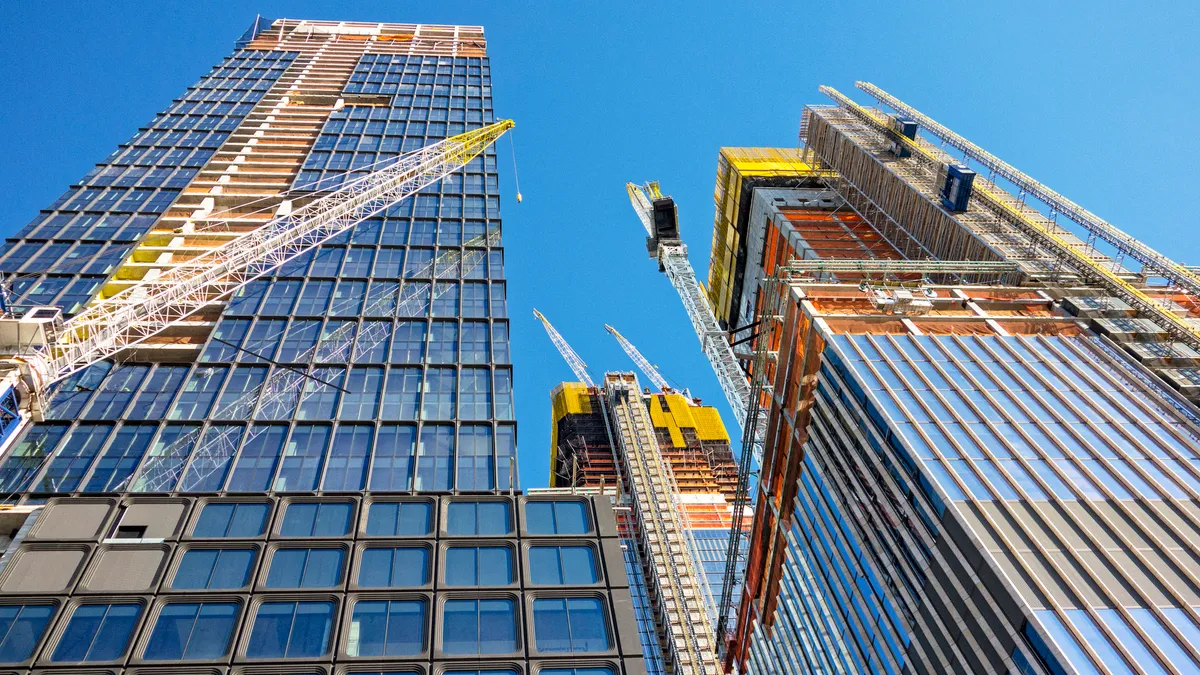Upcoming changes affecting how construction projects in New York City are permitted will have major ramifications for contractors there.
On Dec. 11, the definition of a major building in the city’s building code will change from 10 stories to seven, or 75 feet, incorporating thousands of additional projects.
This means that any major new build, full demolition or interior demolition with mechanical equipment that is seven stories or more will require a site safety coordinator and approved site safety plan.
Without those requirements in place, the projects won’t be able to obtain a permit and begin construction, according to Peter Amato, president of New York City-based construction safety consulting firm Site Safety.
Amato, former assistant commissioner at the New York City Department of Buildings, has over 25 years of experience consulting on thousands of major buildings in New York City. Here, he talks with Construction Dive about the upcoming changes and how to navigate them.
Editor’s note: This interview has been edited for brevity and clarity.
CONSTRUCTION DIVE: With these new changes, how can contractors help make the inspection and permitting process go as smoothly as possible?
PETER AMATO: With the new code changes, smaller contractors may be unfamiliar with how complicated obtaining approvals can be. This is true not only for the DOB but any city or state agency such as the Fire Department, DOT and Department of Design and Construction.

I would say that contractors need to hire professionals to assist them with navigating through the entire application, permit, certificate of occupancy, approval and sign-off processes. Do not attempt to figure it out on your own.
In addition, contractors who have historically built low-rise buildings up to nine stories will need to hire a safety consultant to provide full-time safety professionals and obtain approvals for site safety plans and tenant protection plans. This is an area that they may not understand and I strongly advise them to hire a professional.
How could the new law affect construction work in the city?
Delays in obtaining approvals for a site safety plan will prevent contractors from pulling permits. I have seen job start dates pushed back two to three months because contractors failed to obtain an approved site safety plan. The last thing a contractor wants is to get a stop work order and delay their project.
It is also recommended that contractors be prepared before reaching out to a city agency. Have your team on the same page and have your drawings, application numbers, ideas for how to coordinate logistics and any alternate means to protect the public ready to go and have a lead person coordinate the meeting.
Contractors should start early with any requests for inspections. Know who to call, and how to navigate DOB NOW, the department’s online portal.
What other new requirements are contractors in the city facing?
As of this past January, construction superintendents can only be designated on three permits at one time. In January 2026, this number will be reduced to one permit. (Note that if a superintendent is on a major building, then they cannot be on any more than one permit).
This means that contractors need to be sending their staff for superintendent licenses and Supervisory SST training cards.
In addition, Tenant Protection Plans are required for contractors to obtain whenever performing construction in or on a residential building if one or more resident occupies a dwelling during construction. Some contractors neglect this requirement and are shocked when their project receives a Stop Work Order from the DOB.
Contractors should also note that Tenant Protection Plans must be inspected weekly by a special inspection agency, hired by the building owner.
What does the current shortage of building inspectors mean for contractors in the city?
Considering this shortage, the DOB has been out there performing safety inspections quite well. The larger problem is the delays that contractors deal with when requesting inspections or approvals.
Is it affecting jobsite safety?
I do not see safety affected at this point. In fact, with the site safety training requirements in place, coupled with the new requirement for site safety coordinators on low-rise buildings come December, I anticipate less fatalities than in the past.




















